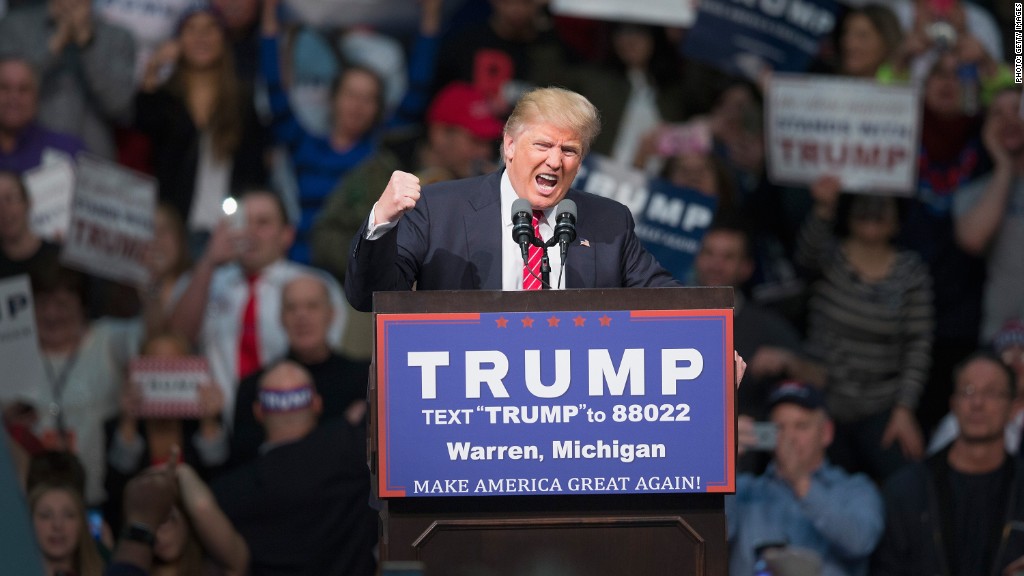
He's a young, talented man chasing the American dream: a car, a house and one day a family of his own. And he just landed a dream job as an engineer at General Electric with good pay.
Except this engineer isn't in America. He's in Mexico.
Carlos is a college-educated, manufacturing engineer who makes $1,500 a month working the production line at a GE plant in Mexico.
He loves GE and sees a future there. His salary works out to about $75 a day.
"I really like my job," Carlos told CNNMoney. "I have to keep working harder and save money so I can get to a better position." (Carlos is not his real name. To protect his job, CNNMoney chose to withhold his name.)
Carlos' aspirations and drive could mirror those of any 24-year old American with similar skills. But his job is in Mexico, where GE has 17 manufacturing plants and 10,000 employees.
Related: America has lost 5 million manufacturing jobs since 2000
A typical manufacturing engineer that works for GE in the United States makes nearly $75,000 a year, according to an analysis of salaries compiled by Glassdoor.
That works out to about $312 a day ... or four times more than Carlos' salary.
That wage gap can easily explain why so many manufacturing jobs have left the United States. Since 2000, the U.S. has lost about 5 million manufacturing jobs.
It's become a hot button topic on the 2016 campaign trail where Donald Trump promises angry Americans that he'll "bring the jobs back from Mexico."
Carlos disagrees.
"I actually don't think that Donald Trump can steal the jobs from here and take them to the U.S.," says Carlos, a huge soccer fan and avid ESPN watcher. "A lot of facilities in the U.S. are coming to Mexico because labor here is cheaper."
Related: Is trade really killing middle class jobs?
Experts agree with Carlos: Manufacturing has crossed the Rubicon -- or Rio Grande -- and it's hard to see those jobs returning to the U.S.
"This promise that we can reverse everything with the snap of a finger is a false siren," says economist Charles Ballard of Michigan State University.
One expert, Robert Scott at the Economic Policy Institute, estimates that the U.S. lost roughly 800,000 jobs to Mexico between 1997 and 2013. He cites NAFTA -- the North American Free Trade Agreement signed in 1993 -- as the key driver for job losses.
Before NAFTA, Mexico's government had restrictions on foreign companies and who they could hire. NAFTA nullified those rules and America's trade deficit with Mexico has ballooned -- meaning we're bringing in a lot more goods from Mexico than we're sending there. That's good for American consumers but bad for manufacturing workers.
Related: I sent my resume to Donald Trump
"The agreement is a failure," says Scott. "We sign trade deals that encourage manufacturing firms to outsource jobs to other countries."
Cheaper labor, lower environmental standards and low export taxes -- or tariffs -- make Mexico an attractive place to move operations, not to mention that it's next door to America. Add on NAFTA -- the success of which is debatable -- and you can see why so many U.S. companies crossed the border. Almost every large U.S. manufacturer, from Ford (F) and General Motors (GM) to Procter & Gamble (PG) and Caterpillar (CAT) has production facilities in Mexico.
GE (GE) declined to comment on salaries of employees in Mexico or the U.S., but a spokesperson said salaries vary by country, skill level and other benchmarks. GE says it has had some operations in Mexico going back to 1896.
Related: Americans fear 'dead end crap jobs'
Carlos is actually doing much better than the typical worker in Mexico.
Manufacturing workers in Mexico earn an average wage of about $13 a day, according to CNNMoney's analysis of Mexican government statistics. The typical assembly line worker in the U.S. makes $25 per HOUR, Labor Department data shows.
Trump's solution to bringing jobs back from Mexico is to raise taxes -- or tariffs -- by 35% on things that come from Mexico, making them more expensive for American buyers.
"It would be a disaster," says Alan Deardorff, an economist at the Gerald R. Ford School of Public Policy at the University of Michigan. "We'd lose a tremendous amount of other jobs."
Trump's tariff plan isn't original. The U.S. increased tariffs on foreign countries in 1930. It didn't work out so well. Other countries raised tariffs on America in retaliation, starting a trade war. The tariff hike was one of the causes of the Great Depression.
How can America create more manufacturing jobs? Invest in Mexico, experts argue. If the United States could help raise wages in Mexico, that would increase the country's middle class and then Mexicans could afford more pricey, American-made products.
"We would have to make major investments in Mexico," says Scott. "There are going to be jobs that move to Mexico ... [but] it's conceivable that we could export other things to Mexico if they had more wealth."
After all, when Carlos earns enough money, guess where he likes to go shopping? Texas.


